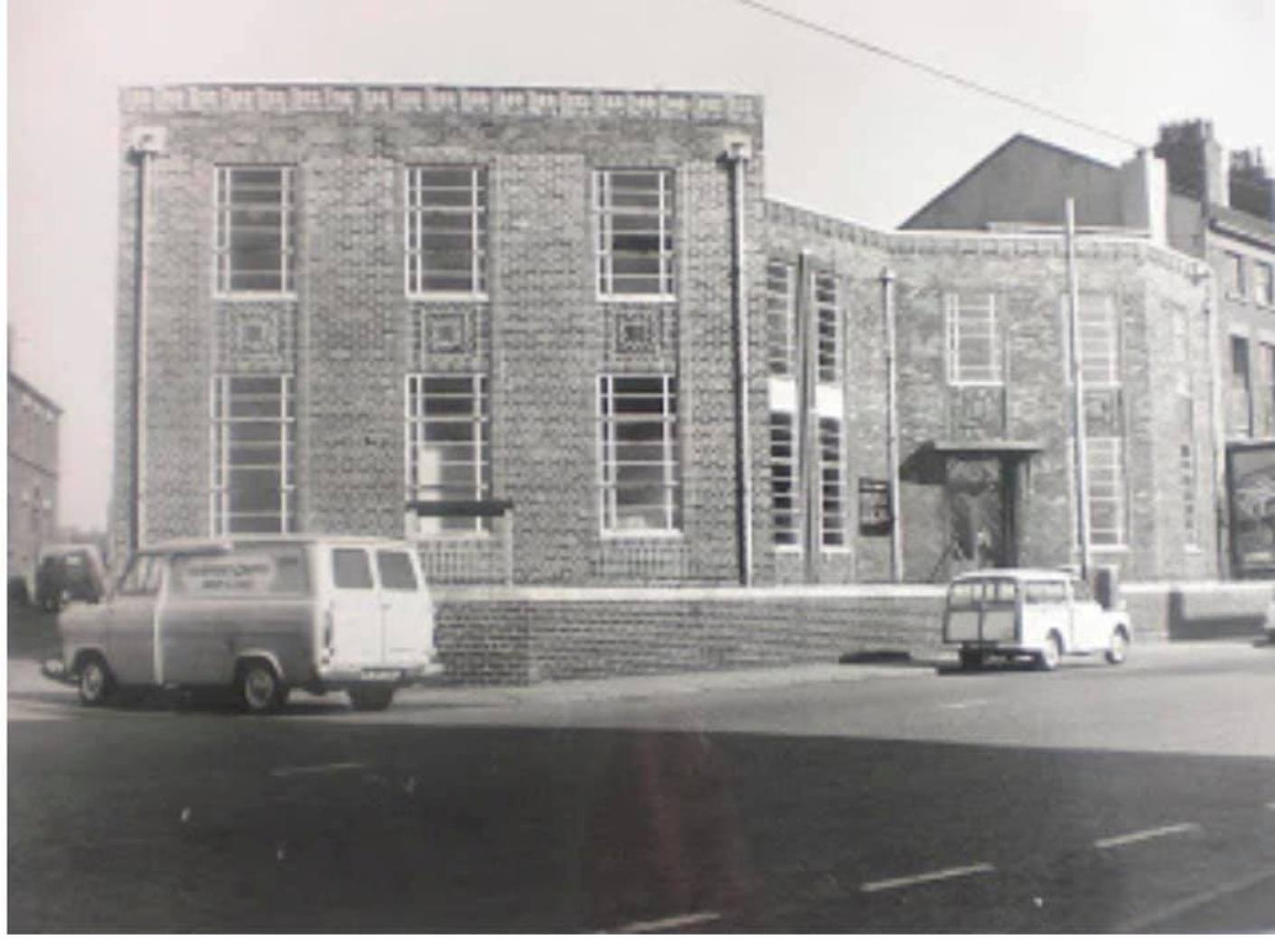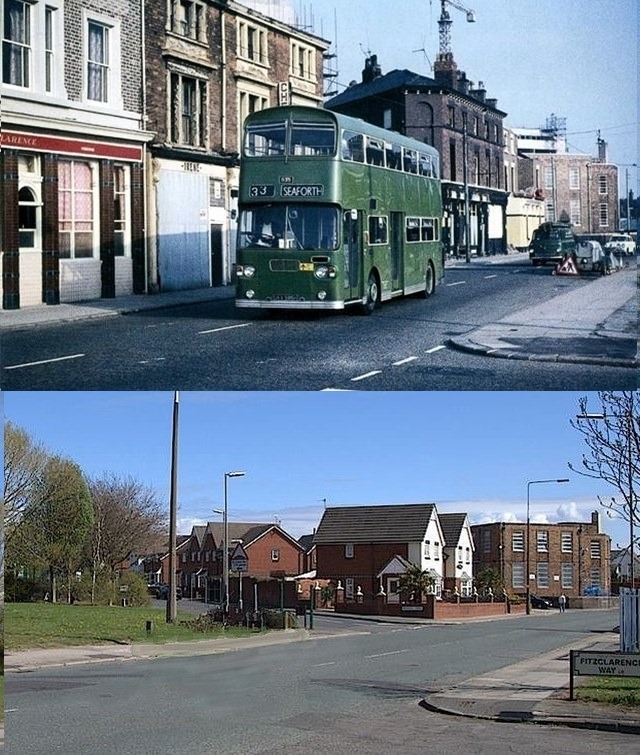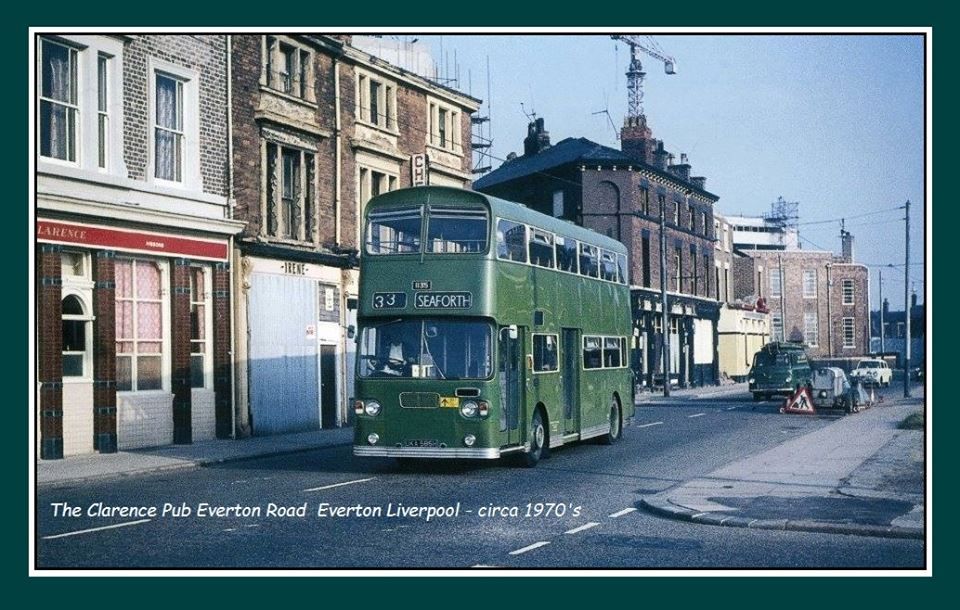Everton Road
-
84 Everton Road was a pub run for many years by my great grandparents Augustus Maybury and Jane Maybury (nee Haskayne). The pub was variously called ‘The Masonic Arms’ and at the time of this photo ‘Mayburys’.

-
Everton Rd pic above showing Bernard Murphy Turf Accountants the shop above was Carneys wholesale Nylons, stockings and socks. My SFX school friend Angela Carney lived there, her dad ran the company, and they sold to the public as well as to wholesale retailers.
-
Everton Road really was countryside in 1828. A beautiful colour image.

-
One of two images on this search of the Fabius Baptist Chapel on Everton Road.

-
A great colourised image from Aubrey Street across Everton Road to Village Street with the church still standing on the corner, long gone now, of course.

-
Everton Road at Aubrey Street and Pepper's Boxing Gym

-
Everton's Road's famous barracks Then & Now, submitted to the Heyworth Street Facebook platform by Jimmy Johnson.

-
The famous former Necropolis that stood at the junction of West Derby Road and Everton Road. This image was brilliantly cleaned up by Mike Pealing. Denis Hargreaves explains that the site was closed in 1898, then landscaped and opened as a public park in 1914, named after Alderman J R Grant, hence Grant Gardens. There are approx 80,000 still buried there with no obvious trace of former gravestone or monuments..

-
Emmanuel Vicarage, Everton Road, 2020.

-
Neptune Hotel, Everton Road, on the corner of Gleave Street. Uploaded to the Heyworth Street Facebook by Denis Hargreaves.

-
The Royal Pub and the Mill Road clinic on Everton Road in 1967.

-
A 25 tram on Everton Road at Aubrey Street, uploaded to the Heyworth Street Facebook by Jimmy Johnson.

-
A wonderful old Liverpool Record Office picture of Everton Road, viewed from the West Derby Road end and uploaded to the Heyworth St & SA Facebook by Jimmy Johnson. The ladies dresses seem to pinpoint this into the Edwardian era.

-
Everton Road at Eastbourne Street, uploaded to the Netherfield Road & S.A. Facebook page.

-
Enjoying another pint or two in The Royal Hotel in Sep 1968 with Arthur Robinson on the left, and Roger Hughes on the right. Although our favourite watering holes on Everton Road were the Royal and the Clarence, we occasionally drank in the rough and ready Neptune Hotel on the corner of Gleave Street, right across from the Barracks. The posters behind us avoid any bias between the two great Liverpool clubs - very diplomatic for the time!

-
Enjoying a pint in The Royal Hotel on Everton Road and the corner of Mill Road, with mates John Mooney, Roger Hughes and Neil Rotheroe in July 1968. Run by lovely couple Jim and Renee - who can just be seen over my left shoulder - this lively, friendly and well-run pub holds many happy memories for me.

-
Early 1900s Everton Road, uploaded to Heyworth Street & Surround Area Facebook by Jimmy Johnson.

-
The Masonic Arms on the corner of Everton Road and Cresswell Street.

-
This image shows the original Army Barracks on Everton Road, part of the property now used by the excellent Everton Red Triangle Karate Club. The facade of this familiar building has been allowed to become extremely dilapidated in modern times, but it would have once been kept in military shape, being the place where many Everton men signed up for the First and Second World Wars.Of course thousands of them would not come back from these devastating conflicts. Indeed, my own grandfather Tom Rogers and my father Harry Rogers would have joined up here. Tom was ultimately wounded twice towards the end of WW1, while my dad was wounded in Burma in WW2. This building will have massive connections and stories linked with thousands of families like mine.

-
Everton Road's art deco style child welfare centre in 1967

-
Everton Road at its junction with Breck Road.

-
Scotts bread shop on the corner of Aubrey Street and Everton Road, near to the top of Village Street.

-
Here is the old weighing machine that was on the corner of Everton Road and Everton Village, pictured in 1904. Lorries would drive on to check their loads. Further down this reel there are two more images of the weighing machine, taken from different angles, but this one gives a tantalising view of the top south side of Village Street with its large properties. A few doors down Village Street was the Queen's Head Hotel where, in 1879, St Domingo church football team took a momentous decision to change its playing name to Everton FC, the start of big time football on Merseyside. I love the adverts on the wall, specifically one for Hartley's marmalade which is particularly relevant. William Hartley, the man who founded the Hartley's Jam empire with a major factory in Long Lane, Aintree, was one of the individuals who willingly put up a significant part of the money that, in 1892, enabled Everton FC to build its new Goodison Park stadium. Perfectly fitting to have a Hartleys advert on a gable end wall around the corner from a major EFC historic site.

-
This was Everton Road in its very early days (1843). Everton House stood just around the corner to what is now the multi junction with West Derby Road, Low Hill, and Brunswick Road. The house, owned by William Gregson who was Liverpool mayor in 1769, had an important local well on its front boundary wall, pictured left in this image). It was widely used by the community in those days. It appears Mr Gregson believed the public road outside his property came too near the front of his house. The overseer of highways, willing to oblige a powerful city character, consented to alter it so as to give adequate space in front of the mansion. Hence the awkward curve that now exists. That unusual kink remains at Everton Road’s junction with West Derby Road. Gregson’s Well was taken down in 1842 although two local pubs kept the name alive, serving beer, not water!

-
The former Millican Chemist on Everton Road on the corner of Cresswell Street.

-
An intriguing view of the busy Everton Road in 1900.

-
A great aerial picture, enabling you to try and pinpoint where your street might have been before the clearances along main routes like Everton Road and Netherfield Road. Landmarks helping us include the Everton Water Tower (top left), Whitley Gardens opposite the big terraced houses on Shaw Street and St Francis Xavier’s church below right on Langsdale Street.

-
The former Fabius Baptist Chapel on Everton Road

-
A wonderfully restored image of the Everton Picture Palace, uploaded originally to the Netherfield Rd Facebook platform by Mike Pealing.

-
Great staff picture of the Arial Gray Co. that once had a dominating presence on on Everton Road. See link picture further down the reel.

-
Everton Road at Cadmus Street.

-
Everton Road Then & Now at the Breck Road Junction, from an original upload to the Heyworth Street & Surrounding Area Facebook platform.

-
Jones' Painting Contractors on Everton Road in 1966.

-
Jimmy Johnson offered this fascinating comparison of Everton Road 'Then & Now' with the famous Clarence Pub no sadly demolished.

-
A slightly grainy but nevertheless fascinating picture of an old tram on Everton Road with the famous Royal Hippodrome cinema (and former theatre and circus) in the background.

-
Everton Road had seen better days when this picture was taken, but the names of some of the old shops can still be seen like Jeanette's, the Top Twenty Store and Vera's For Wools.

-
The YMCA premises on Everton road hold pleasant memories. In the late 60s my girlfriend - Anne (the future (and present) Mrs Mears), was a nursery nurse employed by the YMCA. She, two other girls and the manager, took care of the needs of up to 48 children five days a week - no east task!. I would often meet Anne at the end of her shift and walk her home. Whilst waiting and having an interest in martial arts at the time, I would sometimes watch either the Judo club on the ground floor practising (under the watchful eye of the charismatic Pedro), or the Karate club in their upstairs dojo, under the banner of the Everton Red Triangle. I had the great privilege, around 1969, to meet the esteemed 8th dan Sensei Enoeda, who was instructing at the club and living in Liverpool at the time. A perk was that with Anne working there, when we decided to get married in 1970, we were able to hire, at a discount, the function room for our reception. This was music to the ears of both our parents' who were paying for it! My lovely, now departed mother-in-law, was friends with the Spinners folk group, hence the photo of Janet & Cliff Hall who came to the reception. A bonus was that we were often given free tickets to see the Spinners perform at their regular venue, the Gregsons Well at the top of Brunswick road. One performance stands out in my mind even today; I can still see and hear Hughie Jones' haunting lead vocals of the 'Ellen Vannin Tradegy'. Wow! Stunning! You could have heard a pin drop. Happy days!

-
Myself on the left with Roger Hughes, right, gagging for a pint in one of my favourite pubs, the Clarence on the corner of Everton road and Spencer street, spring 1968.

-
An Air Training Corps meeting in the Everton Road barracks

-
The 'Barracks' on Everton Road which look derelict, if not now demolished, was home to 611 (2nd City of Liverpool) Air Training Corps Sqn throughout the 1960s. I was a member from early 1965 to Sep 1968 when this photo of the inside of the drill hall was taken as I took my last final parade. 611 Sqn - in its RAF form, shot down a number of german aircraft during WW2. Amongst other airfields it was based at was the (now) famous Biggin Hill, sharing in that station's 1000th kill. Many people have heard of the legless ace Douglas Bader, but probably less well known is that 611 Sqn also had a successful legless pilot. In one of our training rooms in the barracks during my time was a piece of a Dornier 215 bomber fuselage shot down by the sqn over Wales in 1940, as shown in this photo.

-
Everton Road Methodist Chapel and Hall. It was situated inbetween Village Street and Rupert Lane.

-
The Clock Pub on the corner of Everton Road and Hodson Place, 1960s.

-
The Everton Picture Palace, looking immaculate in its early days.

-
The famous old weighing machine on the corner of Everton Road and Village Street that would record the load weight of the lorries and trucks that would drive onto this unusual piece of street equipment.The office behind is quite grand, highlighting its former importance, with ornate stone pillars leading to the front door. I love the adverts on the wall to the left, not least for Hartley's Seville Orange Marmalade.

-
Everton Road with the clinic many remember on the right.

-
Inside the old Army barracks square with Everton Road ahead down the narrow tunnel. Many Everton men would have come here to sign on in the First World War. This is all part of a famous stretch of terrace properties on Everton Road, this section of it unhappily run down these days. Up the stairs to the left here is the headquarters of the famous Everton Red Triangle Karate Club.

-
Steve Dempsey's happy memories below of the Everton picture house always reminds me of what my father told me. He said that in the 1930s kids could get in with jam jars which also had a small monetary value at every local rag 'n bone yard, even when I was a kid in the 1950s. Many local district cinemas also accepted this form of payment - remarkable days.
-
Many happy memories of the Everton picture house. My aunt Mary used to give me money to take my cousins Rosemary, and Brian Mitchinson for the afternoon showings, in the schools holidays.
-
The former Poynton's Furniture Removals on Everton Road.

-
Boarded up shops and first floor properties fronted by a distinctive long balcony rail on Everton Road.

-
A fascinating early picture of motor vehicles lined up on Everton Road outside W. Ariel Gray & Co. Picture courtesy of Laurence Furlong.

-
Artist William Herdman loved to capture images of Everton's impressive villas and mansions and here he depicts the grand properties that once stood near to the village on Everton Road with a carriage arriving, possibly to take the impressive couple and their child on the left for a drive along nearby country lanes. The picture is entitled 'Everton Straits of the Village 1830'.

-
Everton Road

-
One of the last remaining mansion style houses on Everton Road.

-
The famous street lamp at the Everton Road junction with Village Street. It's modern concrete replacement, opposite one of the gates to the new Everton Park, doesn't have the same class!

-
From Joan Hatch: A fascinating picture of Everton Road with those unusual first floor terraced properties above boarded up shops behind the railings. There was a similar set of first floor properties on St Domingo Road.

-
Fracas 1871 between the Military and Police... Reported in Liverpool Mercury Sept 12th, 1871 http://liverpoolcitypolice.co.uk/fracas-1871/4555283263

-
The now demolished Clarence Pub on Everton Road

-
One of the large Victorian terraced houses, a feature of Everton Road,

-
Everton Road showing its old and now dilapidated former Army barracks

Thank you for your contribution!
Please check back in 24 hours to see if your photo has been approved.
Return